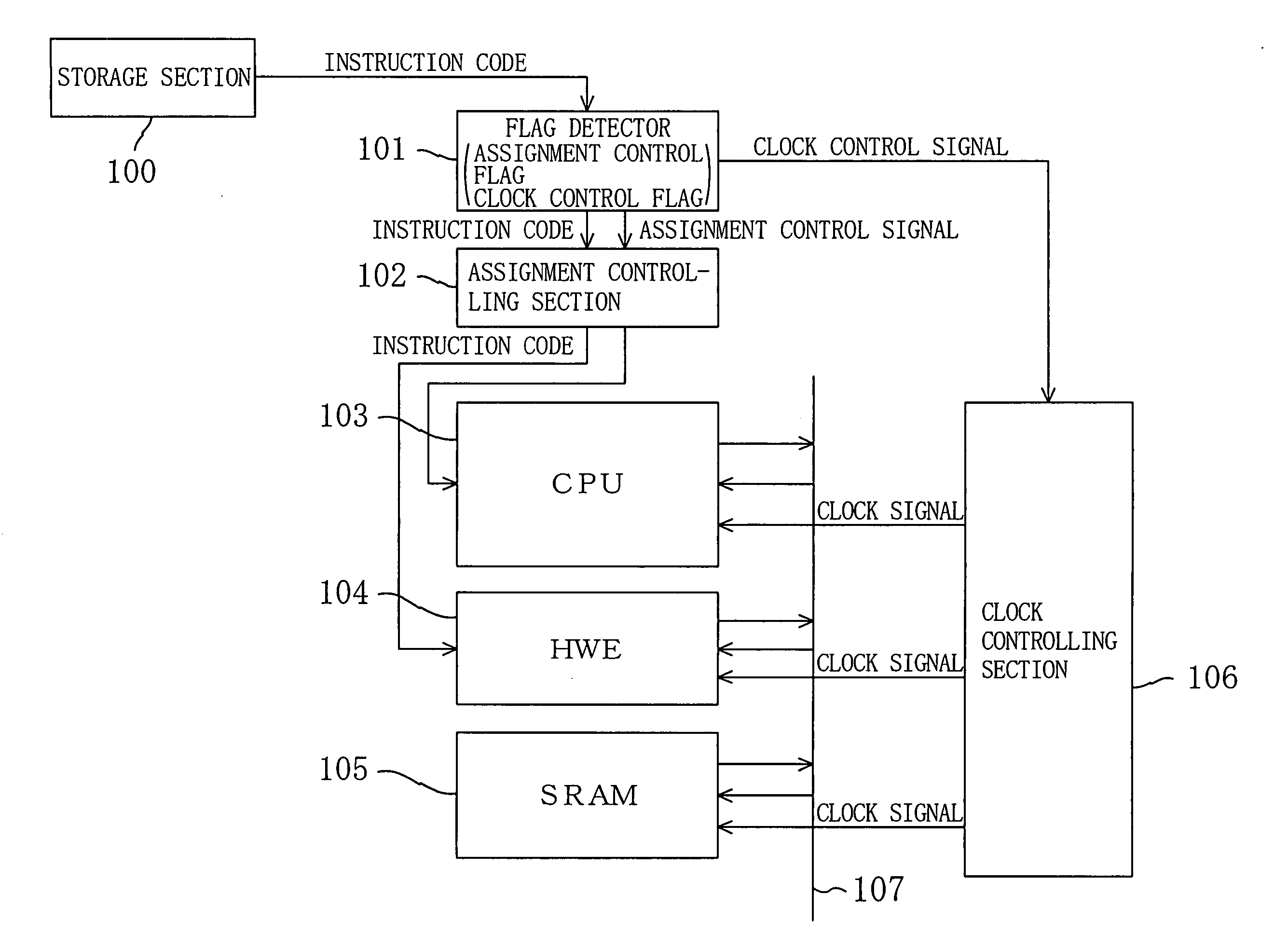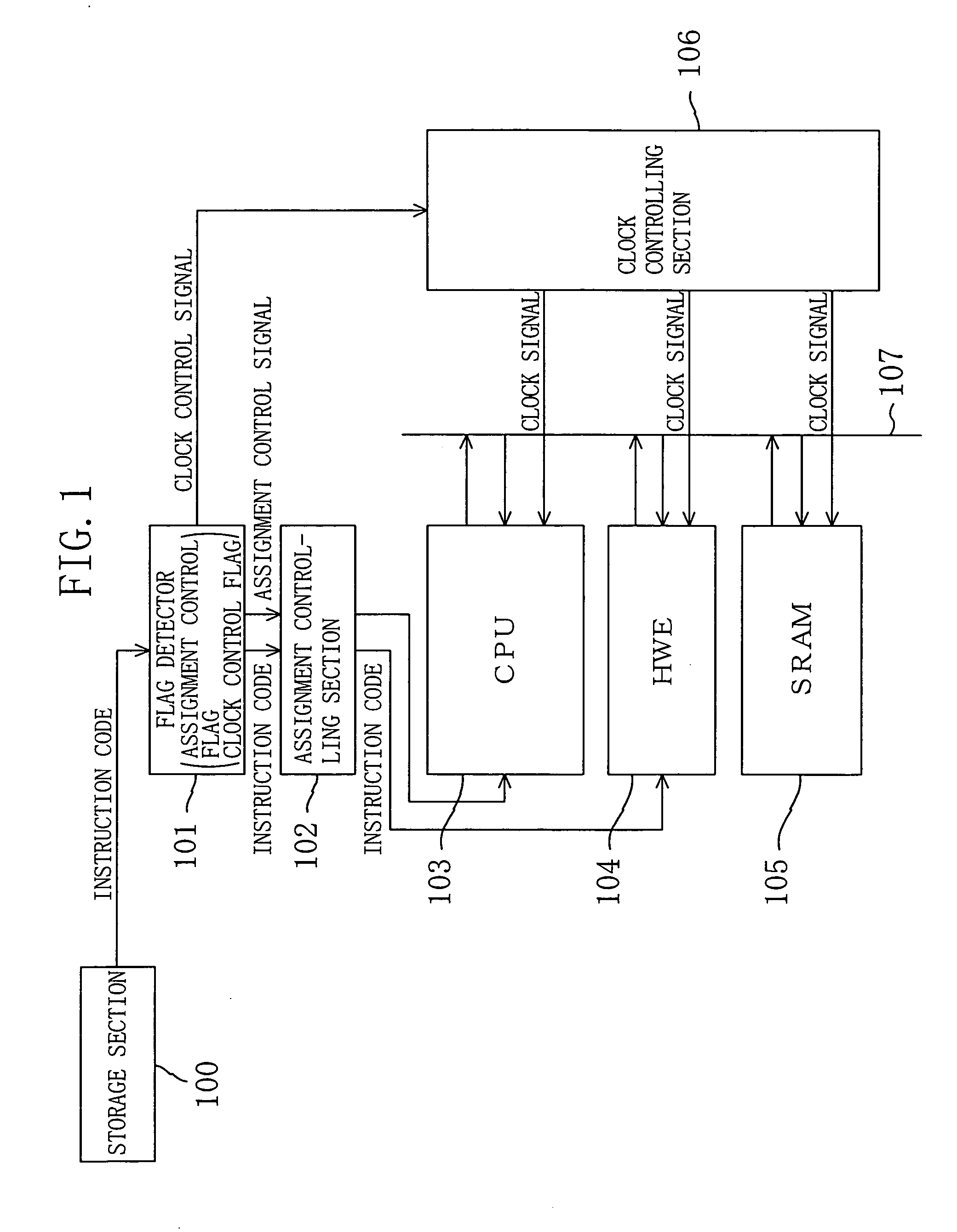Processor system, instruction sequence optimization device, and instruction sequence optimization program
a technology of instruction sequence and optimization device, which is applied in the direction of program control, generating/distributing signals, instruments, etc., can solve the problems of large reduction of power consumption of an entire system, power consumption in processing, and inapplicability, so as to reduce power consumption, reduce power consumption, and maintain processing ability
- Summary
- Abstract
- Description
- Claims
- Application Information
AI Technical Summary
Benefits of technology
Problems solved by technology
Method used
Image
Examples
embodiment 1
[0110] As Embodiment 1, an example in which assignments of instructions to respective modules (functional blocks), e.g., a CPU and a hardware engine (HWE), and control of clock frequencies are performed based on flags added to the instructions in a processor system constituted by a semiconductor integrated circuit will be descried.
[0111]FIG. 1 is a block diagram showing a configuration of a main portion of a processor system. The processor system includes: a storage section 100; a flag detector 101; an instruction assignment controlling section 102; a CPU 103; an HWE 104; an SRAM 105; a clock controlling section 106; and a bus 107. (The flag detector 101 and the instruction assignment controlling section 102 constitute an assignment controlling means, and the flag detector 101 and the clock controlling section 106 constitute a clock controlling means.).
[0112] The storage section 100 stores instruction code of instructions to be executed and is constituted by, for example, a ROM in...
embodiment 2
[0132] Now, an example of an instruction sequence optimization device for generating instruction code to which flags for controlling assignments to processors and clock frequencies are added as described above will be described.
[0133] The instruction sequence optimization device is constituted by a computer for executing programs such as a compiler and an optimizer. A functional configuration thereof is shown in FIG. 7.
[0134] In the drawing, a storage section 201 stores a source program and an object program before and after addition of flags. Examples of the source program include an executable machine language program made of an instruction code sequence, an assembler and a more abstract C-language program. In the case of the assembler program or the C-language program, for example, flags may be added concurrently with translation into a machine language program, or a machine language program to which flags are added may be generated after an intervening program containing infor...
modified example of embodiment 2
[0157] Another instruction sequence optimization device in which a flag is added to instruction code in the same manner as for the instruction sequence optimization device of embodiment 2 will be described. Hereinafter, components having similar functions to those described in embodiments 1 and 2, for example, are indicated by the same reference numerals, and thus description thereof will be omitted.
[0158] In this instruction sequence optimization device, assignments of instructions to processors are determined such that an instruction executable by a plurality of processors is executed by a processor exhibiting the shortest standard execution period, and the clock frequency is determined so as to reduce power consumption based on the assignments. Specifically, as shown in FIG. 10, for example, this device is different from that of embodiment 2 (shown in FIG. 7) in that an assignment determining section 311 and a clock frequency determining section 312 are provided instead of the a...
PUM
 Login to View More
Login to View More Abstract
Description
Claims
Application Information
 Login to View More
Login to View More - R&D
- Intellectual Property
- Life Sciences
- Materials
- Tech Scout
- Unparalleled Data Quality
- Higher Quality Content
- 60% Fewer Hallucinations
Browse by: Latest US Patents, China's latest patents, Technical Efficacy Thesaurus, Application Domain, Technology Topic, Popular Technical Reports.
© 2025 PatSnap. All rights reserved.Legal|Privacy policy|Modern Slavery Act Transparency Statement|Sitemap|About US| Contact US: help@patsnap.com



